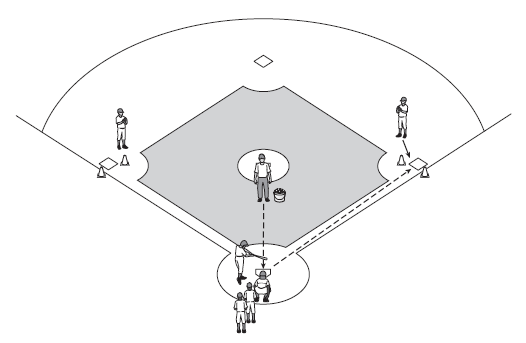Age: 12 and older
Skill Level: Advanced
Introduction
Many coaches are reluctant to have their catchers throw to the bases because of the possibility of throwing errors, especially when a runner is on third base because a mistake in that situation leads to a run. The demands of practice normally leave little time for catchers to work on their pickoff skills. This game, which can easily be played in five minutes each day, gives catchers opportunities to sharpen their throwing skills to first base and third base. It enables them to work on quickening their feet and rapidly transferring the ball from mitt to hand. The key objective is for catchers to make accurate throws to the bases.
 Equipment
Equipment
Cones (tall, if available), baseballs, stopwatch
Setup
- Cones are targets in this game, so use tall ones if available.
- Catchers form a line behind home plate.
- A first baseman and third baseman are at their positions.
- A batter is in the batter’s box.
- A feeder or coach stands 20 feet (6 m) in front of home plate.
Procedure
Place cones on both sides of both first base and third base. One cone should be touching the base in foul territory; the other should be no more than 1 foot (30 cm) inside the base parallel to the first cone. These become targets or goals for the catchers. The first and third basemen should be in ready position on the infield grass a few feet (a meter or so) from the foul line. The batter in the box (who does not swing) switches sides after each throw. The catcher is in receiving position behind the plate.
Play begins when the coach or feeder throws a fastball at moderate speed to the catcher. As the ball is thrown, the coach should clearly call the base to which the catcher should throw by saying, for example, “First, first, first.” The catcher should execute the throwing techniques taught by the coach and throw to the base called. Catchers should aim the ball at the goal formed by the two cones at the base. Fielders catch the throws and return the ball to the coach or feeder. Using the cones reminds catchers that their throws will be more effective when kept lower. Give each catcher three throws before switching catchers.
Coaches can devise their own scoring method but should generally follow this format: Balls thrown within the area bounded by, and no higher than, the cones receive five points; balls in the general vicinity but too high or outside the goal earn three points; and any ball that a fielder has to reach for receives one point. Deduct points for wild throws.
Each throw should also be timed with a stopwatch. Keep records and post them to add an element of competition.
Coaching Points
- Remind catchers not to sit on their haunches and to be in the up position when receiving with runners on base.
- Introduce the knee-drop pickoff throw to first for catchers with strong arms. Because many catchers drop to their knees when returning the ball to the pitcher, runners can be lulled into thinking that the catcher won’t pick when doing this.
- Teach catchers to swing the left knee in the direction of first base just before it hits the ground and to rifle the ball to first. A good throw can catch runners napping.
- Frequently review the catcher’s footwork, transference of the ball, and arm action.